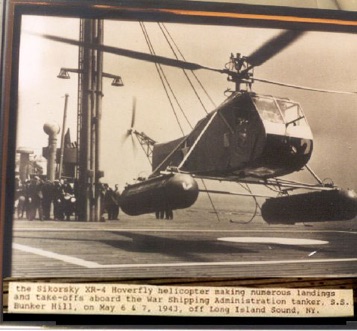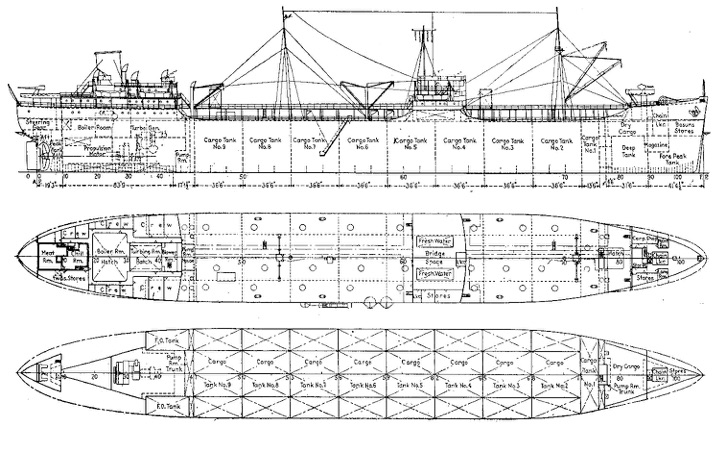S.S. Bunker Hill
The S.S. Bunker Hill was a type T-2 tankship of 10,590 gross tons, 504 feet long, beam 68.2 feet, and 39.2 feet deep. She had a 7,000 horsepower main propulsion unit as compared with the usual 6,000 horsepower unit, brought about by an electrical modification of the main propulsion motor. It was built in 1942 in Chester, Pennsylvania, and owned by Keystone Tankship Corp.

On May 6, 1943 Igor Sikorsky’s (the man who designed the first workable helicopter) R4 helicopter, piloted by Frank Gregory, landed onto the redesigned deck of the Bunker Hill. Sikorsky’s R4 was the first helicopter in history to land on a moving ship, performing a number of rescues and emergency deliveries under field conditions in the last year of WWII.
Type T-1 tankers were named after major oil fields in the U.S., Type T-3 tankers were built for private companies, thus named after them. But, type T-2 tankers, like the Hill, were named after monuments, national parks, forts, historic settlements, trails, lakes, swamps, or battles.

Bunker Hill, with redesigned deck, June 1943 Courtesy Guy LeValley (also Sikorsky heli photo)
On March 6, 1964, at about 4:02 a.m., the Bunker Hill was sailing from Tacoma, Washington to Anacortes, Washington cruising at about 15 knots in Rosario Strait. All storage tanks that usually held various fuels, were empty except for number 6, It was full of ballast. All of a sudden there was a violent explosion between the midship house and the after deck house. The Hill proceeded to break in that very spot. The forward section veered to port and the aft section continued to list starboard. The two sections of the ship were connected for a brief time, then finally broke apart.
Rattlling the windows of the Naval Air Station Control Tower some 5 miles away, two navy men were able to alert the Coast Guard and send out rescue units immediately. Within 45 minutes all survivors were rescued. A total of 5 men, Captain Michael J. Abraham, Junior Third Mate Ronald W. Lockwood, Quartermaster Robert S. Smith, Steward Harold W. Schmidt, and Chief Mate Robert H. Blake, were lost and presumed dead in the incident.
In an investigation later, the cause of the accident was reported as follows:
“To control corrosion in the cargo tanks, a combination of sacrificial magnesium anodes and a chemical wash system had been installed. The wash system had been discontinued; however, the special piping which had been installed had not been removed.” It had been reported several times that pieces of the deteriorated piping had fallen into the tanks. “Evidence also shows that the magnesium anodes were deteriorated and the steel bolts which fastened their brackets to the supporting structure were wasted.”
When the cargo was discharged in Tacoma, the orders were to wash the tanks and draw vapor out using a gas exhauster, or bazooka as the crew called it. The bazooka was used in each of the 9 tanks for about 5 minutes making the vapor levels at the “critical range” for explosion. It is the belief that since the Bunker Hill had no cargo it was vibrating while underway, and worked loose some piping or a magnesium anode which in turn fell to the bottom of the vapor filled No. 9 tank, caused a spark, and ignited the vapor thus creating the first explosion. Shortly thereafter the No. 4 tank ignited and exploded and sent several crewmen into the water.
With her hull split in two, explosions continuing to go off, and fire spreading rapidly it took less than an hour for the Bunker Hill to completely sink in two pieces.
She now lays at the bottom of Rosario Strait in 280 feet.
FROM THE USCG ACCIDENT REPORT

Courtesy T2 Tanker page





Courtesy Puget Sound Maritime Historical Society







-
-Home
